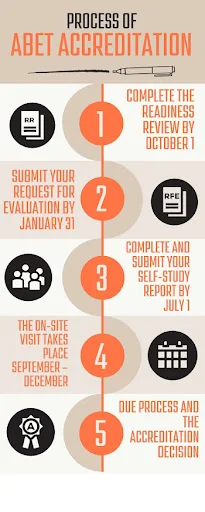Title: Evaluation Criteria of ABET Accreditation System
Introduction
The ABET (Accreditation Board for Engineering and Technology) Accreditation System is internationally recognized for evaluating and certifying the quality of academic programs in the fields of applied science, computing, engineering, and engineering technology. The heart of the ABET accreditation process lies in its comprehensive evaluation criteria, which ensure that educational programs prepare graduates to meet the demands of their respective professional fields.
This article explores the key evaluation criteria used by ABET, explaining each in detail and highlighting how these standards guide institutions in fostering academic excellence and continuous improvement.
1. General Evaluation Structure
ABET evaluates academic programs (not institutions) through one of its four commissions:
-
EAC – Engineering Accreditation Commission
-
ETAC – Engineering Technology Accreditation Commission
-
CAC – Computing Accreditation Commission
-
ANSAC – Applied and Natural Science Accreditation Commission
Each commission has general criteria applicable to all programs and program-specific criteria that vary depending on the discipline.
2. General Criteria for All Programs
ABET’s General Criteria consist of eight standard categories applicable across all commissions. These categories form the foundation of program evaluation:
Criterion 1: Students
This criterion assesses the procedures and policies that govern student admission, transfer, academic advising, monitoring of academic progress, and the program’s ability to ensure student success.
Key Requirements:
-
Clear admission and transfer policies
-
Availability of support services (advising, counseling, mentoring)
-
Documented processes for evaluating and tracking student performance
-
Demonstration of how students achieve program outcomes
Criterion 2: Program Educational Objectives (PEOs)
PEOs are broad statements describing the career and professional accomplishments that graduates are expected to achieve a few years after graduation.
Key Requirements:
-
PEOs must be published and regularly reviewed with input from stakeholders (faculty, industry, alumni)
-
There should be a documented, systematic process for review and revision of PEOs
-
Objectives must align with institutional mission and program goals
Criterion 3: Student Outcomes (SOs)
Student Outcomes are what students are expected to know and be able to do by the time of graduation. These directly relate to the skills and knowledge needed in the workforce.
Key ABET Outcomes for Engineering (EAC Example):
-
Apply knowledge of mathematics, science, and engineering
-
Design and conduct experiments, and interpret data
-
Design systems or processes within constraints
-
Work in multi-disciplinary teams
-
Identify and solve engineering problems
-
Understand professional and ethical responsibility
-
Communicate effectively
-
Understand the impact of engineering solutions
-
Engage in lifelong learning
-
Understand contemporary issues
-
Use modern engineering tools
Note: Outcomes are evolving with the adoption of new ABET criteria. Institutions may define their own outcomes aligned with these.
Criterion 4: Continuous Improvement
This criterion emphasizes a cycle of assessment, evaluation, and enhancement.
Key Requirements:
-
A documented and implemented process for the periodic assessment of student outcomes
-
Systematic evaluation of assessment results
-
Evidence of actions taken to improve the program
-
Demonstration that these actions led to measurable improvement
Criterion 5: Curriculum
The curriculum must support achievement of student outcomes and program educational objectives.
Key Requirements:
-
A minimum number of credit hours in math, science, engineering topics, and general education (varies by commission)
-
Integration of design experience throughout the curriculum
-
Up-to-date course content aligned with current industry practices
-
Curriculum mapping to student outcomes
Criterion 6: Faculty
Faculty members must be qualified and sufficient in number to cover all curricular areas and maintain an atmosphere conducive to learning.
Key Requirements:
-
Faculty credentials and expertise in relevant subject areas
-
Participation in curriculum development, assessment, scholarly activities
-
Opportunities for professional development
-
Faculty-to-student ratios that support effective teaching
Criterion 7: Facilities
Facilities must be adequate to support student learning and faculty teaching.
Key Requirements:
-
Classrooms, laboratories, computing resources, and equipment must be modern, safe, and sufficient
-
Access to libraries, software, internet, and research infrastructure
-
Regular maintenance and upgrade of resources
Criterion 8: Institutional Support
This includes financial and administrative support necessary to run the program effectively.
Key Requirements:
-
Budgetary allocations for program operations
-
Administrative leadership and autonomy of the department
-
Staffing for advising, lab support, and technical services
-
Long-term institutional commitment to program sustainability
3. Program-Specific Criteria
Each discipline (e.g., Electrical Engineering, Mechanical Engineering, Computer Science) has program-specific criteria that include additional requirements such as:
-
Specific subject areas to be covered (e.g., circuits, electromagnetics for EE)
-
Required laboratory experiences
-
Tools and techniques relevant to the field
-
Capstone or design project specifications
These criteria are reviewed by professionals from the discipline and are periodically updated to reflect industry changes.
4. Evaluation Process Using the Criteria
-
Self-Study Report (SSR): Institutions submit a comprehensive report addressing all ABET criteria.
-
On-Site Visit: Evaluation team visits the campus to verify documentation, review student work, interview faculty/students, and assess facilities.
-
Exit Meeting: Observations and potential deficiencies are shared with the institution.
-
Final Review: ABET commissions review findings and make accreditation decisions.
Conclusion
The evaluation criteria of the ABET Accreditation System are designed to ensure that academic programs not only meet educational standards but also adapt to evolving industry needs. Through clearly defined and rigorously applied criteria, ABET fosters a culture of accountability, quality, and continuous improvement in technical education.
Whether you are an educator, administrator, or prospective student, understanding these criteria helps you appreciate the significance of ABET accreditation as a hallmark of excellence and readiness for the professional world.

Comments
Post a Comment
"Thank you for seeking advice on your career journey! Our team is dedicated to providing personalized guidance on education and success. Please share your specific questions or concerns, and we'll assist you in navigating the path to a fulfilling and successful career."